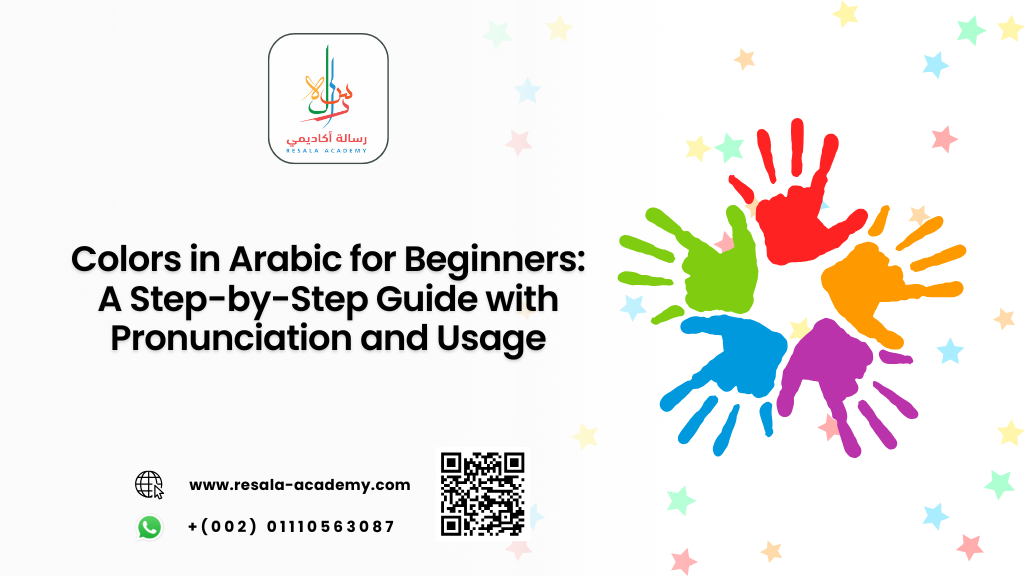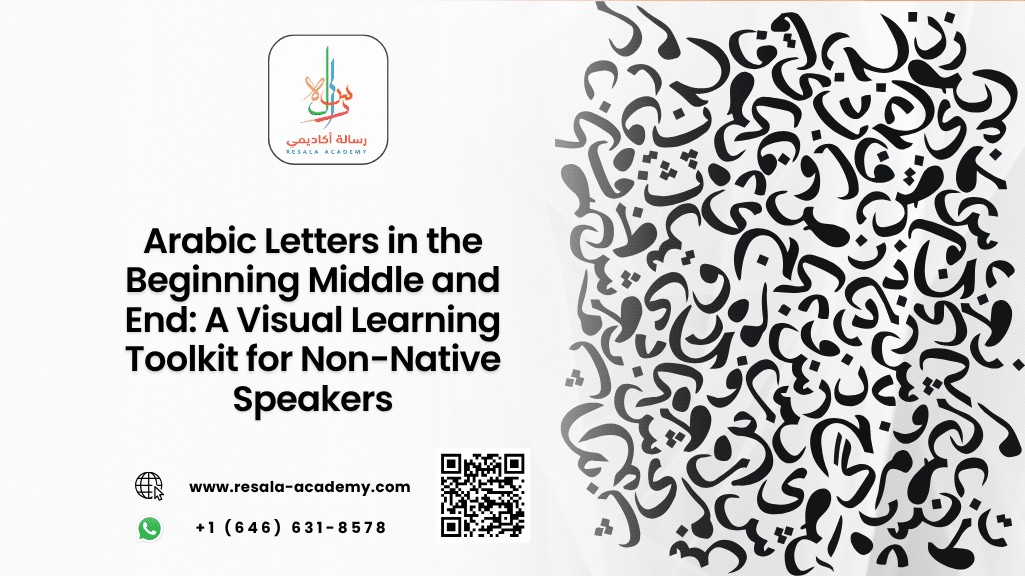Table of Contents
Colors in Arabic for Beginners: A Step-by-Step Guide with Pronunciation and Usage
Learning a new language opens doors to new cultures, perspectives, and opportunities. When it comes to Arabic, one of the most expressive and poetic languages in the world, mastering the basics—such as vocabulary related to colors—is an essential step.
In this comprehensive guide, we’ll explore Colors in Arabic, their pronunciation, usage in daily conversation, and cultural significance. Whether you’re a complete beginner or brushing up on your skills, this guide is tailored for non-native speakers and language enthusiasts.
Throughout the article, we’ll also highlight how Resala Academy stands out as a premier online platform for learning Arabic, especially for those starting their journey.
Why Learn Colors in Arabic?
Colors are among the first vocabulary sets taught in any language course. They’re essential for:
- Describing objects, people, and places.
- Expressing preferences and emotions.
- Understanding cultural references.
- Enhancing conversational fluency.
In Arabic, colors carry deep cultural meanings and are often used in idioms, poetry, and religious texts. Learning them not only improves your vocabulary but also connects you with the rich heritage of the Arabic-speaking world.
The Basics: Understanding Colors in Arabic
In Arabic, the word for “color” is لون (lawn), and the plural is ألوان (alwān). Arabic colors change form depending on gender and number, which is a unique feature of Semitic languages.
Masculine and Feminine Forms
Most colors in Arabic have both masculine and feminine forms. The masculine form is the base, and the feminine form is usually created by adding a taa marbuta (ـة) at the end.
| English | Arabic (Masculine) | Arabic (Feminine) | Pronunciation |
|---|---|---|---|
| White | أبيض | بيضاء | abyad / bayḍāʼ |
| Black | أسود | سوداء | aswad / sawdāʼ |
| Red | أحمر | حمراء | aḥmar / ḥamrāʼ |
| Blue | أزرق | زرقاء | azraq / zarqāʼ |
| Green | أخضر | خضراء | akhḍar / khaḍrāʼ |
💡 Tip: When describing a feminine noun (like سيارة – car), use the feminine form of the color: سيارة حمراء (a red car).
Read more about: How to Memorize the Days of Week in Arabic Language in Under 30 Minutes
Pronunciation Guide for Arabic Colors
Arabic pronunciation can be tricky for beginners. Here’s a breakdown of some common colors with phonetic guidance:
- أبيض (Abyad) – White
- أسود (Aswad) – Black
- أحمر (Ahmar) – Red
- أزرق (Azraq) – Blue
- أخضر (Akhḍar) – Green
- أصفر (Asfar) – Yellow
- برتقالي (Burtuqāli) – Orange
- بني (Bunni) – Brown
- رمادي (Ramādi) – Gray
- زهري (Zahri) – Pink
- ذهبي (Dhahabi) – Golden
- فضي (Fiḍḍi) – Silver
You can listen to native pronunciation and practice with interactive lessons at Resala Academy’s Online Arabic Courses.
Advanced Color Vocabulary in Arabic: Beyond the Basics
While beginners often start with primary hues, expanding your knowledge of Colors in Arabic to include nuanced and descriptive terms can significantly enhance your fluency and comprehension. These advanced color expressions are frequently used in literature, fashion, and design contexts, offering a deeper linguistic and cultural insight.
- Pastel Shades: Arabic includes terms for soft, muted tones like وردي فاتح (light pink) and أزرق سماوي (sky blue), which are commonly used in art and interior design.
- Metallic Colors: Words like ذهبي (golden) and نحاسي (copper-colored) are essential in describing jewelry, décor, and traditional attire.
- Natural Tones: Descriptors such as لون الرمال (sand color) or لون الزيتون (olive color) are rooted in the natural landscapes of Arabic-speaking regions.
- Color Pairings: Arabic often combines two colors for specificity, such as أخضر مزرق (bluish green) or أبيض مائل للرمادي (off-white/grayish white), which are useful in fashion and design discussions.
- Symbolic Hues: Shades like أحمر قاني (crimson red) or أسود حالك (jet black) are rich in emotional and poetic connotations, often found in Arabic literature and media.
By integrating these expressive terms into your vocabulary, you’ll not only speak more vividly but also better appreciate the depth of Arabic expression. Resala Academy offers specialized modules that explore these advanced terms in context, perfect for learners aiming to refine their descriptive skills.
Usage of Colors in Sentences
Let’s explore how to use colors in everyday Arabic sentences:
Describing Objects
الكتاب أحمر.
Al-kitāb aḥmar.
→ The book is red.السيارة زرقاء.
As-sayyārah zarqāʼ.
→ The car is blue.
Expressing Preferences
أحب اللون الأخضر.
Uḥibb al-lawn al-akhḍar.
→ I love the color green.ما لونك المفضل؟
Mā lawnuka al-mufaḍḍal?
→ What’s your favorite color?
Cultural Expressions
- الراية البيضاء – The white flag (symbol of peace or surrender)
- الذهب الأسود – Black gold (refers to oil)
Cultural Significance of Colors in Arabic-Speaking Countries
Colors in Arabic culture often carry symbolic meanings:
- White (أبيض) – Purity, peace, and cleanliness.
- Black (أسود) – Power, mystery, or mourning.
- Green (أخضر) – Islam, paradise, and fertility.
- Red (أحمر) – Passion, danger, or celebration.
- Blue (أزرق) – Protection against the evil eye.
Understanding these meanings can help you navigate conversations and cultural contexts more effectively.
How Colors Change with Gender and Plurality
Arabic is a gendered language, and adjectives—including colors—must agree with the noun they describe.
Gender Agreement
- ولد أسود (walad aswad) – A black boy
- بنت سوداء (bint sawdāʼ) – A black girl
Plural Agreement
- أولاد سود (awlād sūd) – Black boys
- بنات سوداوات (banāt sūdāwāt) – Black girls
This grammatical structure is taught in detail in Resala Academy’s grammar-focused modules, making it easier for learners to grasp these concepts.
Common Phrases Using Colors
Arabic uses color-based idioms and expressions that add flavor to the language:
- قلبه أبيض – His heart is white (He is kind-hearted)
- نظرته سوداء – His view is black (He is pessimistic)
- أيامه رمادية – His days are gray (His life is dull)
These phrases are often used in literature and everyday speech, and mastering them helps learners sound more native.
Color Variants and Shades
Arabic also includes words for shades and variants of colors:
- فاتح (fātiḥ) – Light
- أزرق فاتح – Light blue
- غامق (ghāmiq) – Dark
- أخضر غامق – Dark green
- لامع (lāmiʿ) – Shiny
- أحمر لامع – Shiny red
These modifiers are essential for more precise descriptions and are covered in Resala Academy’s vocabulary expansion lessons.
Cognitive Benefits of Learning Colors in Arabic for Language Acquisition
Understanding and using Colors in Arabic goes beyond vocabulary—it plays a vital role in cognitive language development, especially for non-native speakers. Incorporating color terms into your learning routine can accelerate memory retention and contextual understanding.
- Visual Association: Associating Arabic color words with real-life objects (e.g., تفاحة حمراء – red apple) strengthens neural connections and aids long-term retention.
- Grammar Reinforcement: Using colors helps reinforce adjective-noun agreement rules in Arabic, a critical grammar concept for fluency.
- Cultural Immersion: Learning color-related idioms and proverbs deepens your cultural understanding and enhances your ability to interpret native content.
- Contextual Learning: Describing environments, clothing, or emotions using color terms provides practical language use in everyday scenarios.
- Multisensory Engagement: Combining visual, auditory, and verbal practice with colors—such as through Resala Academy’s interactive tools—stimulates multiple areas of the brain, optimizing language acquisition.
By leveraging the psychological and linguistic advantages of mastering color vocabulary, learners can build a strong foundation in Arabic while enjoying a more engaging and immersive experience.
Learn Colors in Arabic with Resala Academy
If you’re serious about learning Colors in Arabic and mastering the language from the ground up, look no further than Resala Academy. With expert instructors, interactive lessons, and a curriculum designed for non-native speakers, you’ll gain confidence in speaking, reading, and writing Arabic in no time.
What Resala Academy Offers:
- Live classes with native Arabic teachers
- Beginner to advanced levels
- Cultural immersion and real-life usage
- Flexible schedules and mobile access
- Pronunciation practice and grammar drills
Join Resala Academy Today and paint your Arabic learning journey with success!
FAQs
1. How do I remember the gender forms of colors in Arabic?
Arabic adjectives must agree in gender with the noun they describe. A helpful tip is to learn the noun and its gender along with the color. For example, سيارة (car) is feminine, so use زرقاء (blue – feminine).
2. Are color names used differently in Modern Standard Arabic and dialects?
Yes, while the base names remain similar, pronunciation and usage can vary across dialects. For example, أزرق (blue) in Egyptian Arabic might be pronounced slightly differently. Resala Academy covers both MSA and dialects to give you a well-rounded education.
3. Can I use colors as nouns in Arabic?
Absolutely. For example, الأحمر can mean “the red one.” This is common in Arabic poetry and literature. Example: أحب الأحمر أكثر من الأزرق – I like the red one more than the blue one.
4. How can I practice colors in Arabic daily?
Try labeling household items with their Arabic color names, use flashcards, or describe things around you in Arabic. Resala Academy also offers daily practice exercises and quizzes.
5. Are there any apps or resources to help with Arabic color vocabulary?
Yes! Resala Academy’s online platform includes vocabulary lists, pronunciation tools, and interactive games.
Conclusion
Mastering Colors in Arabic is more than just memorizing vocabulary—it’s about understanding how language, culture, and expression intertwine. From gendered forms to idiomatic expressions, colors offer a vibrant entry point into the Arabic language.
Whether you’re learning for travel, work, or personal enrichment, Resala Academy provides the tools, guidance, and support you need to succeed. With expert instructors, engaging lessons, and a focus on real-world usage, you’ll be speaking Arabic confidently in no time.
Ready to add color to your language journey? Start learning with Resala Academy today!




